Books
Books
published in 2024

Fail Worse
It was the year that autofiction was everywhere.
All the major authors were accused of writing autofiction. You, the reader, were reading autofiction, maybe even writing autofiction yourself. The little known author HWK also was working towards his own autofiction, cycling through London, drafting, redrafting, scrapping, and scraping by, spiraling through his own mind, a geography of ambient anxiety, and a rising sea of associations and dead ends. As the tides begin to overwhelm him, HWK finds lifelines in the various stories that float past.
Possible rescuers, including Ben Lerner, Maggie Nelson, Sheila Heti, Mario Levrero, Jay Sherman (best known by his professional title, The Critic), and the noted animated therapist Dr. Katz call out to our narrator from the shores of literary and cultural success, will he reach them before the waters close over his head? Will HWK, dear reader, reach you?
Fail Worse is the smartest novel I’ve read in a long time, at once a scathing and hilarious critique of the limitations and conventions of autofiction as well as a moving work of personal narrative. I want to give copies of this novel to every writer I know. – Madeleine Watts, author of The Inland Sea
A brilliantly audacious and thoroughly ridiculous book – skewers its subject with a grandeur and wit it scarcely deserves… a stained glass window thrown at a pebble. – Keiran Goddard, author of I See Buildings Fall Like Lightning

Logorrhea
The fruit of a long-term project, this artist's book focuses on the written word and language in Jean-Michel Wicker's work.
Since the 1990s, the work of French artist Jean-Michel Wicker (born 1970 in Riedisheim, lives and works in Berlin) has focused on all forms of production, including publishing, typography, performance, and gardening. Wicker is the founder of the publishing houses Le edizioni della luna, Nice, Le edizioni della china, Berlin, and Ballabella papers, Berlin. His recent solo exhibitions include Edouard Montassut, Paris (2017), Bergen Kunsthall (2015), Sandy Brown, Berlin (2015), Künstlerhaus, Stuttgart (2015), Cubitt, London (2014), New Theater, Berlin (2014), Artists Space, New York (2013), Kunsthalle Bern (2012), and KW Institute for Contemporary Art, Berlin (2010). He has also exhibited in group shows, including the Institute of Contemporary Arts, London (2014), Kunsthal Charlottenborg, Copenhagen (2011), and Kunsthalle Zürich (2011).

Survival Is a Promise: The Eternal Life of Audre Lorde
A bold, innovative biography that offers a new understanding of the life, work, and enduring impact of Audre Lorde.
We remember Audre Lorde as an iconic writer, a quotable teacher whose words and face grace T-shirts, nonprofit annual reports, and campus diversity center walls. But even those who are inspired by Lorde’s teachings on “the creative power of difference” may be missing something fundamental about her life and work, and what they can mean for us today.
Lorde’s understanding of survival was not simply about getting through to the other side of oppression or being resilient in the face of cancer. It was about the total stakes of what it means to be in relationship with a planet in transformation. Possibly the focus on Lorde’s quotable essays, to the neglect of her complex poems, has led us to ignore her deep engagement with the natural world, the planetary dynamics of geology, meteorology, and biology. For her, ecological images are not simply metaphors but rather literal guides to how to be of earth on earth, and how to survive―to live the ethics that a Black feminist lesbian warrior poetics demands.
In Survival Is a Promise , Alexis Pauline Gumbs, the first researcher to explore the full depths of Lorde’s manuscript archives, illuminates the eternal life of Lorde. Her life and work become more than a sound bite; they become a cosmic force, teaching us the grand contingency of life together on earth.

All Fours
The New York Times–bestselling author of The First Bad Man returns with an irreverently sexy, tender, hilarious, and surprising novel about a woman upending her life
A semifamous artist announces her plan to drive cross-country, from LA to New York. Twenty minutes after leaving her husband and child at home, she spontaneously exits the freeway, beds down in a nondescript motel, and immerses herself in a temporary reinvention that turns out to be the start of an entirely different journey.
Miranda July’s second novel confirms the brilliance of her unique approach to fiction. With July’s wry voice, perfect comic timing, unabashed curiosity about human intimacy, and palpable delight in pushing boundaries, All Fours tells the story of one woman’s quest for a new kind of freedom. Part absurd entertainment, part tender reinvention of the sexual, romantic, and domestic life of a forty-five-year-old female artist, All Fours transcends expectation while excavating our beliefs about life lived as a woman. Once again, July hijacks the familiar and turns it into something new and thrillingly, profoundly alive.

The Last Sane Woman
A beguiling debut novel about friendship and failure, written with unusual craft and spryness by an acclaimed poet
Nicola is a few years out of a fine arts degree, listless and unenthusiastically employed in London. She begins to spend her hours at a university archive dedicated to women's art, because she 'wants to read about women who can't make things'.
There she discovers one side of a correspondence beginning in 1976 and spanning a dozen years, written from one woman – a ceramics graduate, uncannily like Nicola – to her friend, who is living a contrasting and conventionally moored life. As she reads on, an acute sense of affinement turns to obsession, and she abandons one job after another to make time for the archive.
The litany of coincidences in the letters start to chime uncomfortably, and Nicola's feeling of ownership begets a growing what if she doesn't like what the letters lead to?
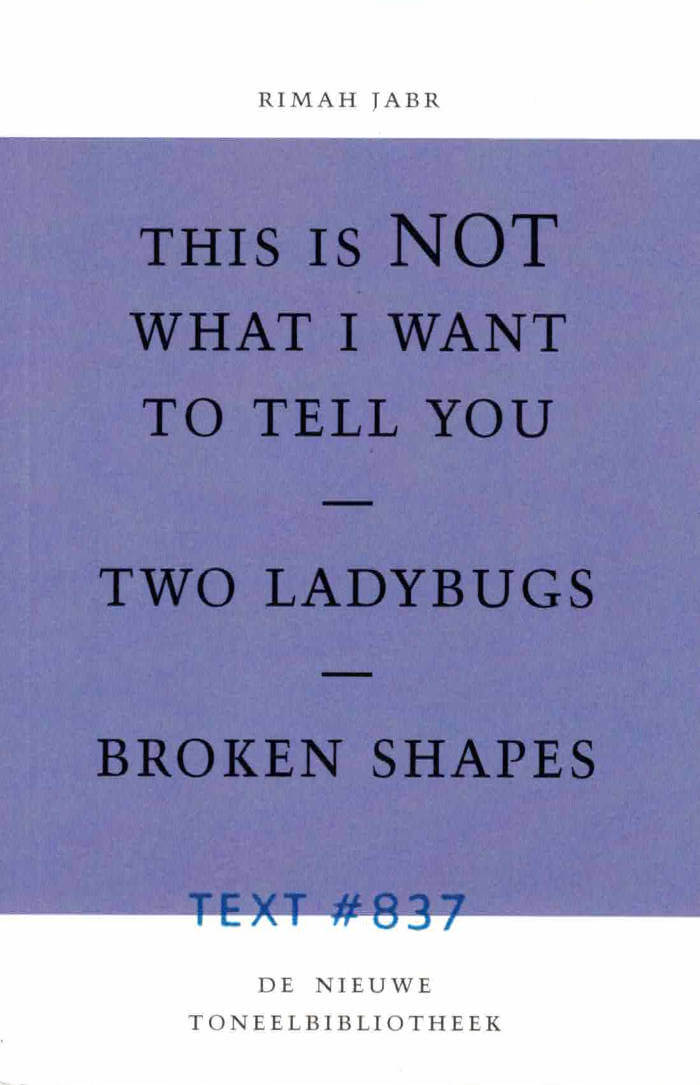
This is NOT what i want to tell you
In This is NOT what I want to tell you: she looks at the many attacks carried out by teenagers in Palestine in 2015 and 2016. The teens, all children aged between 10 and 15, were shot dead or sentenced to years in prison. The series of almost daily knife attacks by these lone wolves reflected the hopelessness and despair among the young people of Palestine. They wanted to send a message to the world, but were unable to convey this in ordinary language.
In Two Ladybugs the fates of three characters, a Belgian woman, a Palestinian girl and an Israeli soldier, are closely intertwined. The players don't feel comfortable in this new, strange world and they don't hide that from the public.
Broken Shapes: A young woman in a city that has been occupied for decades, on the day of her father’s funeral, discovers his architectural drawings. Overcome with grief, she slips into the dream worlds and imagined places that he created.
Rimah Jabr Rimah Jabr (Nablus, Palestine, 1980) is a theatre director, playwright, screenwriter and Ph.D. candidate in Theatre and Performance Studies at York University. She completed a master’s degree in theatre-making from the RITCS in Brussels. She wrote and directed several plays produced in Belgium, Canada, and Palestine. She actively collaborates with visual artists to craft unique performances. Her doctoral research is a performance ethnography research-creation with Palestinian Designers from Hebron, examining the impact of confinement on the creative process involved in set design. Broken Shapes is a collaborative project co-created by Toronto-based theatremaker Rimah Jabr and Brussels-based visual artist Dareen Abbas.

GLEAN - Issue 5 (ENG edition)
Guest editor: Orla Barry, City Report Brussels: Maxime Fauconnier and Natural Contract Lab, Kasper König, Kendell Geers, Lucy McKenzie, Nástio Mosquito, Lisa Vlaemminck, Paloma Bosquê, Joar Nango, Sandrine Colard, Wu Tsang, Busan Biennale

poussière de seum
“the following text was written in July 2024 in St Imier, Switzerland.
it's a fragment of Lettres à Bébé, a book I've been writing for some time in which I - Ethan - find myself helping and communicating by letter with a Marxist Baby whose political project is not to grow up so as not to become a tool of Capital. While he develops his project and tells it to me, I live my life and tell it too, observing and commenting on the ignoble state of the world, its language, its architecture, managing my heartbeat, meeting people, working, fucking, eating (...)”. - Ethan Assouline
Published by La Dépendance, St imier (2024)

Sketchbook 1-10
“Sketchbook 1-10” with Antoinette d’Ansembourg bundles a complete collection of pocket sketches created between 2020 and 2023, stretched across ten different notebooks. These sketches, despite their two-dimensionality, form the mainstay of her sculptural output, offering a glimpse into the intimate process behind her stately installations.

Flower Engine
the second poetry collection from Natalie Briggs titled ‘FLOWER ENGINE’. This collection of cinched, bright free-verse explores the passing locations of love and the slow, private operations of pain’s knocking counterweight. The book extends Briggs’ relay of concise universal suggestions, translating them through brief, intimate utility.

CLOUDS
Clouds are, narratively speaking, some tricky things. They are both full and empty. They are vacant and shifting, a site of tension between the material and the immaterial, the perceptible and the invisible. Clouds is also the title of German artist Esther Kläs’ first monograph, which spans over 15 years of sculptures, drawings, and performances. As an organic rendering of a complex practice, this book mirrors both the formal impact of each artwork and the conceptual outreach of a collection of gestures, attitudes, movements, and moods happening around the works. Because Esther’s practice has no tight borders or hard edges. Each piece escapes definition and breaks loose from the patterning power of language. Still, regardless of the medium, everything Kläs does seems to have a common denominator: it is a reiteration of a way of thinking – her way of thinking – through a body in space – her body, as well as a social body.
With four commissioned contributions (Marc Navarro with Ester Partegàs, Julie Boukobza, Chloe Chignell, and Francesco Pedraglio) and six short, loose texts edited by Elena Tavecchia and Kläs herself, the book is a canvas whose patterns shift following the artist’s elaborated work. What stays hovering in the air are sparks of decisions, constant movements, recurrent repetitions, and propositions.
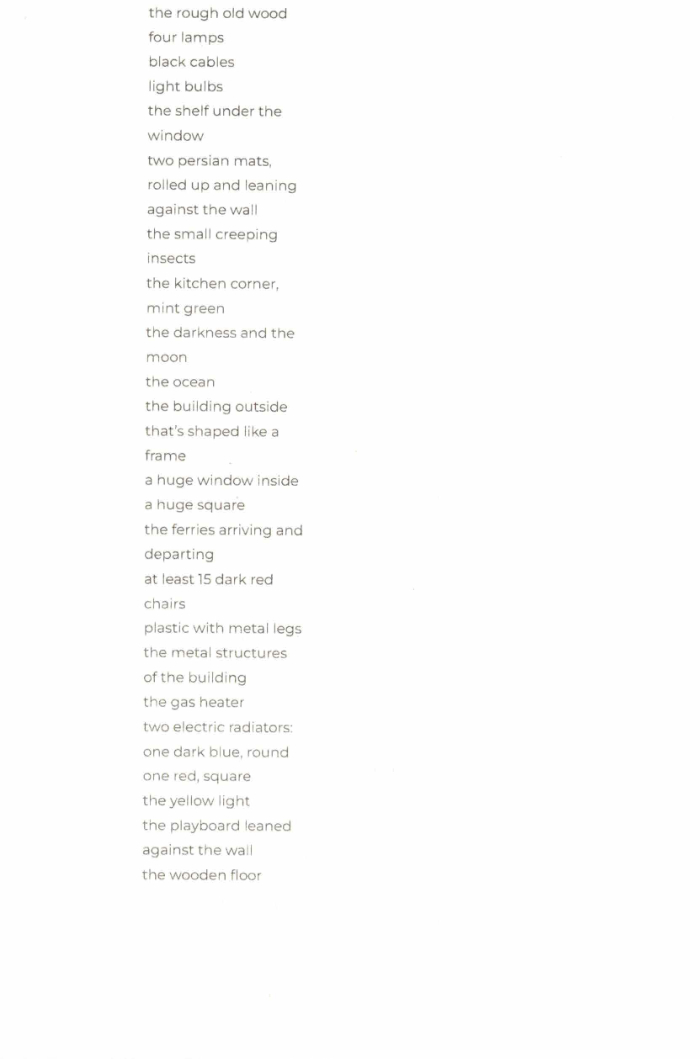
It Absorbs: On Dance as a Porous Art Object
It Absorbs: On Dance as a Porous Art Object is an essay written alongside the making of the piece dead dead document that premiered at MDT in Stockholm 2024. The essay was published in a publication that was presented together with the Reading Edge Library. The text traces contextual and material histories that the process was engaging with and questions the relationship between dance as artistic practice and place aswell as an an economy that force artists to move on.

KAMERA CAHIER N° 10
A special edition issue curated, designed and published by AVARIE, Paris and Labor Neunzehn, Berlin. It accompanies KAMERA SERIES, while it is an independent and valuable object to collect. The central idea that informs and directs the booklets’ montage is the interplay between the concepts of addition and subtraction. This is achieved by unveiling a missing image in the screening or an unreleased second from an artist's film, expanded to 24 pages. Additionally, each booklet contains a piece directly removed from the show.
The editing establishes a dialogue between film frames and performed writings derived from texts, scripts, storyboards, and notes. The KAMERA exhibition is consequently extended into a physical space—the book—allowing for its widespread dissemination, complementing and contrasting with its potential online occurrence.
KAMERA SERIES is a screening program of experimental films, video art works and printed matter taking place in a former GDR building in Berlin. Each event showcases a retrospective of selected films by an artist and a small exhibition of his/her publications or works on paper over a span of 4 days.
KAMERA centers on fostering a critical dialogue between different film formats and artists’ books. Through its regular occurrence, it aspires to create a space for community exchanges about contemporary image-making. KAMERA is a series conceived and curated by Labor Neunzehn and AVARIE.
Fascinated by the intersection of visual art and cinema, Helga Fanderl’s short poetic films evoke intense and sensitive experiences of the real world. Using a small hand-held super 8 camera, she creates filmic responses to her perceptions, weaving together imagery and emotions in dense, rhythmic patterns solely through in-camera editing. She presents silent films in the form of ‘compositions’, crafting unique programs for site-specific personal projections and transforming spaces into temporary cinemas.

KAMERA CAHIER N° 9
Peter Downsbrough (New Jersey, US, 1940) lives and works in Brussels (Belgium). Associated with major international art movements such as minimal art, conceptual art, and visual poetry, his work spans across various mediums including sculpture, wall pieces and room pieces, books, work on paper, photography, film, and video. The work, which has affinities with architecture and typography, explores the traditional use of space and language, while criticizing power structures, e.g. urbanism, that influence social interactions and shape the landscape.
A special edition issue curated, designed and published by AVARIE, Paris and Labor Neunzehn, Berlin. It accompanies KAMERA SERIES, while it is an independent and valuable object to collect.
The central idea that informs and directs the booklets’ montage is the interplay between the concepts of addition and subtraction. This is achieved by unveiling a missing image in the screening or an unreleased second from an artist's film, expanded to 24 pages. Additionally, each booklet contains a piece directly removed from the show.
The editing establishes a dialogue between film frames and performed writings derived from texts, scripts, storyboards, and notes. The KAMERA exhibition is consequently extended into a physical space—the book—allowing for its widespread dissemination, complementing and contrasting with its potential online occurrence.
KAMERA SERIES is a screening program of experimental films, video art works and printed matter taking place in a former GDR building in Berlin. Each event showcases a retrospective of selected films by an artist and a small exhibition of his/her publications or works on paper over a span of 4 days.
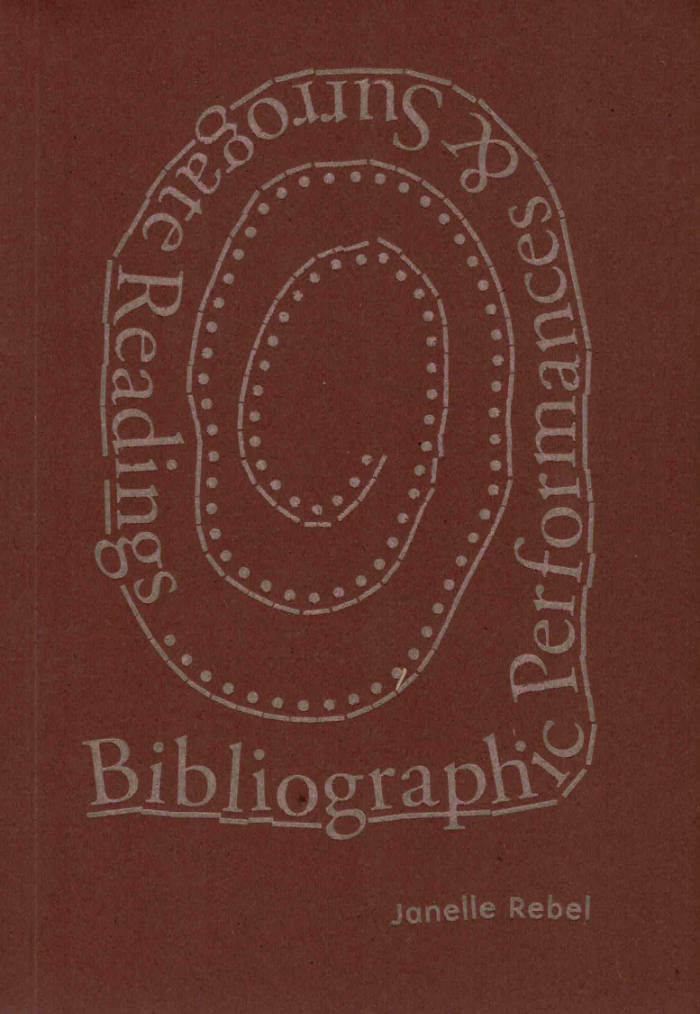
Bibliographic Performances & Surrogate Readings
Bibliographic Performances & Surrogate Readings delves into the imaginative realm of books and libraries and the interpretive structures of subject bibliographies.
It is the first monograph of its kind to historicize, theorize, and survey two decades of what the author refers to as contemporary visual bibliography or experimental subject bibliography—artistic and poetic projects that explore artifactual, intellectual, spatial, and design possibilities.
Ranging from artists’ books and web data-bases to stack interventions and reading room installations, Bibliographic Performances & Surrogate Readings reviews over fifty compelling visio-bibliographic examples created by diverse, international cultural workers.
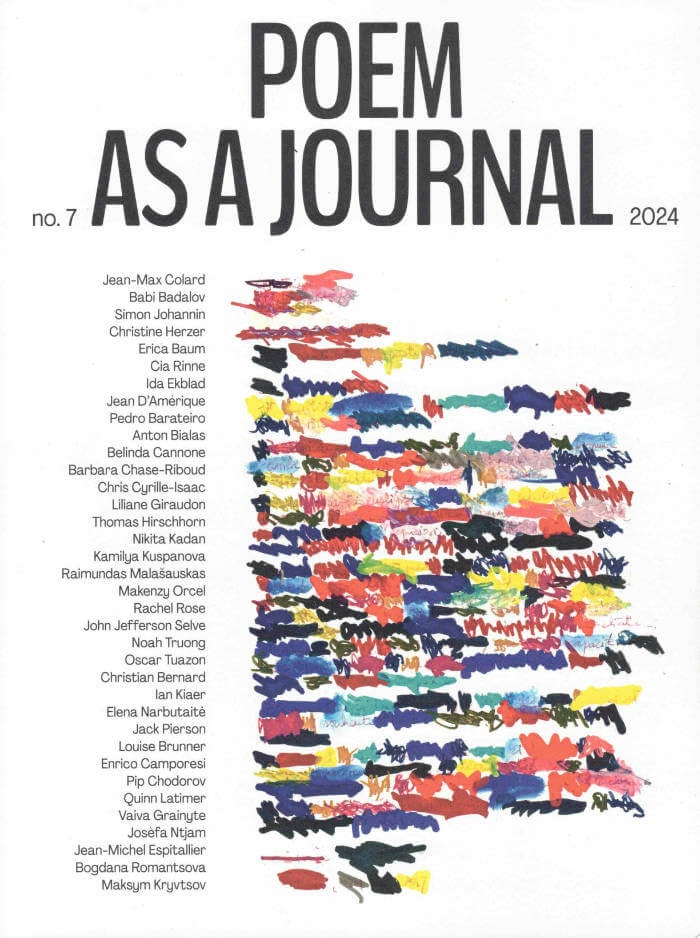
Issue 7: Poem as a Journal
What sparked off this issue of as a Journal was the clear evidence of poetry’s growing presence in the field of contemporary art. Rather than ‘Poetry’ in general, and even less so the figure of the ‘Poet’, it’s the poem that has our full attention: I find it in the title of an exhibition by Jason Dodge, on the invitation card sent out by artist Ida Ekblad, and then again in the form of an exhibition, in the display and arrangement of works within a space by Ian Kiaer, Elena Narbutaitė or Wolfgang Tillmans. Hence this open-ended question, ‘What is poetry for you today?’, placed like a probe among various art world players, in a sort of vox populi.
And so rises the confirmation of an intuition: in an art field driven by the market, where artworks are becoming luxury accessories for the jet set, poetry, with its poverty and economy of means, appears at the opposite end of the spectrum, as a pole of resistance.
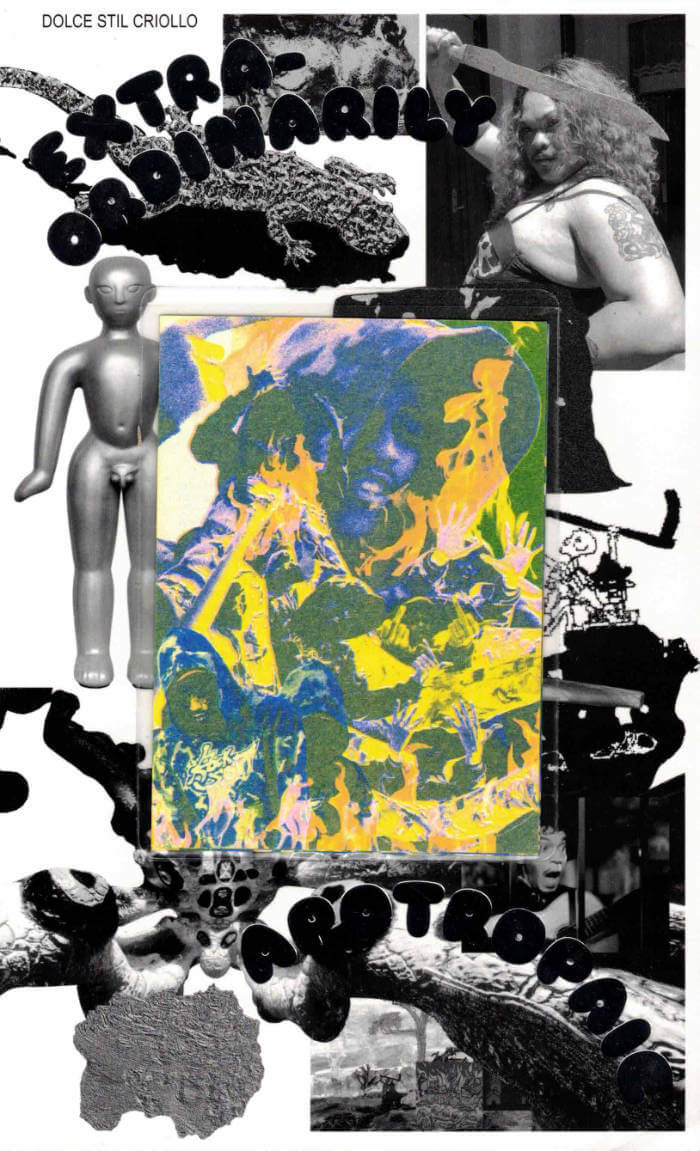
Dolce Stil Criollo Issue 5: Extraordinarily Apotropaic
Dolce Stil Criollo’s fifth issue, "Extraordinarily Apotropaic," aims to rethink reality in its current ordinary form by discovering and creating charms and rituals for changing it into one where there is less harm. The issue features poems in multiple languages; a map of dreams; a video game-turned-manga; a section that functions as a kineograph; a collaboration with the Huni Kuin people; and more. We also curated a collective project, “Cinema of Hope,” which brings together 11 moving image artists in search of the apotropaic moment, caught on film.
The cover of our fifth issue features one of five “santinho” inserts. Designed like prayer cards, they contain a collaged portrait of a musical artist (Pivaratu, Pivete Nobre, Iya, Swatch, Devil Gremory) on the recto and the rap lyrics they wrote in response to our theme on the verso.
Contributors include Andrés-Monzón Aguirre, Aykan Safoğlu, Azul Caballero Adams, Belinda Zhawi, Daniel Machado, Daniel Moura, Devil Gremory, Enorê, Esvin Alarcón Lam, Gabriel Massan, Hick Duarte, Itamar Alves, Iya, Jennifer Pérez, Jesse Cohen, Johan Mijail, Juan Pablo Villegas, Kasra Jallilipour, Kent Chan, Keratuma (Mileidy Domicó), Laura Huertas Millán, Lucía Melií, Lucía Reissig & Bernardo Zabalaga, Maria Thereza Alves, Masha Godovannaya, Mayada Ibrahim, Najlaa Eltom, NIna Djekić, Ophelia S. Chan, Pivaratu, Pivete Nobre, Ricardo Pinheiro (Ganso), Roberto Tejada, Sofía Córdova, Sofía Gallisá Muriente, Swatch, Thales Pessoa, and Thiago Martins de Melo.
Languages: Spanish, Portuguese, English, Japanese and Arabic
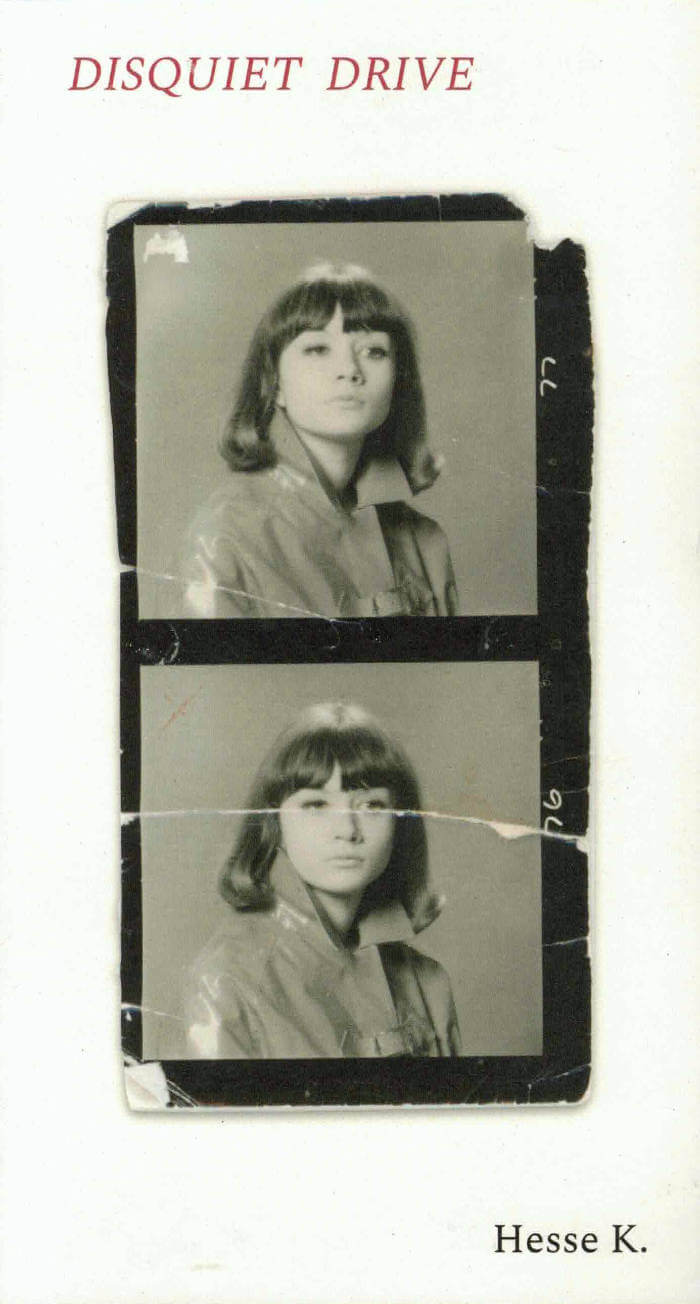
Disquiet Drive
One night a satellite falls out of the sky and splits a girl in half. Disquiet Drive is a book scraped together from the shorn parts of a person who may no longer exist. Beginning with an admission that language and embodiment seem indistinguishable, yet refusing to claim a singular voice, the texts in this collection lurch between the fiery crucible of a transition and the weird jaggedness of our own continuity; between inverted memoir and prose-poetry; the raw, irrepressible lyric and the essay as an exercise in the art of digging-one’s-heels-in. Disquiet Drive is about undoing the words we’re handed so that language can survive, and undoing the body so that it can find a way to live.
'Disquiet Drive is restlessly exquisite. Hesse K’s writing vibrates with the quiet solar intensity of a planetary body that can’t be looked at directly: things slip, slink, snick and lick into each other, limning a gorgeous periphery where genre, past and future selves, follies, fossils and hormones collide. I can’t remember when I last read something as exhilarating, beautiful and deeply attuned to the implications and contradictions involved in struggling towards a bearable world, and the ‘undomesticated sensibility’ it requires of us.' — Daisy Lafarge, author of Lovebug
'Buck wild and entirely unique, Disquiet Drive took me to the beautiful and chaotic edge of the universe and made me want to write (live) for 200 years.' — Eliot Duncan, author of Ponyboy
Hesse K. is a writer. Her criticism and poetry has appeared in MAP magazine and Montez Radio, and in anthologies by Sticky Fingers Publishing, Toothgrinder, Worms and Pilot Press, among others. She lives in London.

Salvation
Salvation is a previously-unpublished artist book by Jimmy DeSana that he conceptualized shortly before his death in 1990. The publication contains 44 of the artist’s late photographic abstractions that quietly and poetically meditate on loss, death, and nothingness. Depicted within the works are images of relics, body parts, flowers, and fruits that DeSana altered using collage and darkroom manipulations to create pictures that are both intimate and other-worldly. Salvation provides a nuanced and sophisticated counterpoint to the prevailing work around HIV/AIDS at the time, which tended to favor bold political statements.
Variations of many of the works in this book were first presented at DeSana’s last show with Pat Hearn Gallery in 1988. Shortly thereafter, the artist began assembling a maquette of Salvation, using black and white images as place holders for the color works that he intended to comprise the final layout of the publication. Sadly, he was unable to fully realize Salvation in his lifetime, but on his deathbed, he dictated instructions to his longtime friend Laurie Simmons for completing the work; instructions which she noted on each page of the single-copy maquette. With these notes, Simmons was able to match extant slides and sequencing. Simmons’ studio chose color gels from DeSana’s archive for each corresponding black and white image in the assembly of the publication. Thankfully, due to this recuperative work, Salvation—long-considered to be DeSana’s last major work—is now available for the first time, with every step taken to honor and embody DeSana’s original vision.
Jimmy DeSana (1949-1990) grew up in Atlanta, GA, and received his bachelor’s degree from the Georgia State University in 1972 before relocating to New York’s East Village in the early 1970s. Recent solo and two-person exhibitions include The Sodomite Invasion: Experimentation, Politics and Sexuality in the work of Jimmy DeSana and Marlon T. Riggs, Griffin Art Projects, Vancouver, Canada, 2020, and Remainders, Pioneer Works, Brooklyn, NY, 2016. DeSana’s work can be found in numerous public collections including the Institute of Contemporary Art, Boston, MA; Metropolitan Museum of Art, New York; Museum of Contemporary Art, Chicago, IL; Museum of Fine Arts, Houston, TX; Museum of Modern Art, New York, NY; and the Whitney Museum of American Art, New York, NY, among others. A major retrospective of DeSana’s work was exhibited at the Brooklyn Museum, New York, in 2022, accompanied by a catalogue co-published by the Brooklyn Museum and DelMonico Books.

JJ – Tartine-moi et autres textes
JJ brings together articles by cultural critic, auto/biographer, and lesbian icon Jill Johnston, translated into French for the first time, as well as texts, poems and drawings by Pauline L. Boulba, Aminata Labor, Nina Kennel and Rosanna Puyol.
Jill Johnston (1929-2010) was a dance critic, performer, writer, and feminist and lesbian activist. Her books include Marmalade Me (1971), Lesbian Nation (1973), Gullibles Travels (1974) and numerous articles in The Village Voice.
Texts by Jill Johnston; contributions by Pauline L. Boulba, Aminata Labor, Nina Kennel, Rosanna Puyol.
Translated from the English (American) by Pauline L. Boulba, Aminata Labor, Nina Kennel, Rosanna Puyol.
Graphic design: Sophie Demay & Maël Fournier-Comte (In the Shade of a Tree).

Bonbons à l'anis
Un fabuleux recueil – le premier publié en français – de poèmes et récits de l'autrice argentine Cecilia Pavón, préfacé par Chris Kraus (écrivaine dont Pavón a par ailleurs traduit des livres en espagnol).
« Cette traduction n'aurait pu voir le jour si je n'avais pas développé pendant quelques temps une obsession quasi malsaine pour l'Argentine. Cherchant à Buenos Aires les traces de lieux proches de Shanaynay que j'avais co-dirigé à Paris, je découvris au hasard sur internet l'existence d'un espace nommé Belleza y Felicidad et dirigé par Fernanda Laguna et Cecilia Pavón. Bien avant l'émergence de l'artist-run space en Europe, les deux femmes créèrent un lieu associant art et littérature. Lors d'un voyage à Buenos Aires, j'eus l'opportunité de rencontrer Cecilia Pavón qui lors d'une conversation sur l'écriture et la poésie, me proposa de traduire Licorice Candies en français. Sa poésie fut autant révélatrice qu'émancipatrice, à la fois par sa singularité et sa simplicité. Elle écrit ce qu'elle voit et ce qu'elle vit. Elle parle de certains quartiers de Buenos Aires, de ses amis, d'elle, d'un vélo qu'elle a perdu, de Timo. Il me semble qu'elle écrit comme elle parle d'amour, d'erreurs et de sexe ». Marion Vasseur Raluy, traductrice
The first collection of texts published in French by the Argentinian artist and poet.
Preface by Chris Kraus.
Translated from the English and Spanish by Marion Vasseur Raluy, Rosanna Puyol Boralevi and Mona Varichon.

Love Poems
Three long poems by American writer, artist and actor Rene Ricard (1946-2014), an icon of the New York underground in the 1970s, accompanied by a series of drawings by American painter Robert Hawkins.
After Rene Ricard 1979–1980 and God with Revolver, Editions Lutanie publishes a third collection of poetry by the American writer, artist, and actor Rene Ricard (1946–2014), Love Poems.
Reprising the rare, eponymous book published by Richard Hell through CUZ Editions in 1999, Love Poems features three poems by Ricard and a series of black-and-white drawings by Robert Hawkins). Haunted by death, betrayal, and guilt, Ricard's poems speak from a wounded heart. Hawkins's accompanying drawings have the simplicity of children's book illustrations, but feature menacing shadows, broken cigarettes, used condoms, and petal-less flowers.
Translated into French by Manon Lutanie and Rachel Valinsky, and presented in a bilingual edition, the poems are followed by a newly commissioned afterword by Hawkins retracing his encounter, friendship, and collaboration with Ricard.
With Love Poems, Editions Lutanie reaffirms its decade-long commitment—initiated the year of Ricard's passing—to reissue his out-of-print works for English-speaking readers, while also presenting them for the first time to a French-speaking audience.
"With three simple poems, Rene Ricard exposes us to the often strained love within class stratification, between those coming together from different worlds, whether Bowery panhandlers or street hustlers, Hollywood movie stars or the highest echelon of European aristocratic wealth. Rene Ricard writes poems that are always honest. Sometimes painfully so."
—Patrick Fox
Robert Hawkins (born 1951 in Sunnyvale, California) is an American artist who lives and works in London. A fabled figure of the 1980s and early 1990s East Village art and punk scene, his work is and has been collected by artists and writers including Jean-Michel Basquiat, Glenn O'Brien, and Jim Jarmusch. Among Hawkins' first exhibitions was Lower Manhattan Drawing Show, a group exhibition curated by Keith Haring at 77 White Street Gallery above the Mudd Club, in 1981.
Rene Ricard was an American writer, artist, and actor. He was born in 1946 and grew up in New Bedford, Massachusetts. After a troubled childhood, he fled to Boston as a teenager, where he came into contact with literary and artistic circles. At the age of eighteen, he moved to New York City and became a central figure in the city's artistic and literary scene. Ricard appeared in several films by Andy Warhol and continued to act in many independent films throughout his life. In the 1980s, he wrote two major collections of poetry, as well as important essays and articles, some of which were instrumental in launching the careers of artists such as Julian Schnabel and Jean-Michel Basquiat (about whom he wrote the famous article "The Radiant Child" in Artforum in 1981). Beginning in the 1990s, he developed a pictorial body of work and exhibited his paintings in various galleries in the UK and the US. He died in New York in 2014.
Edited by Manon Lutanie .
Translated from the English (American) by Manon Lutanie and Rachel Valinsky.
Drawings and afterword by Robert Hawkins.
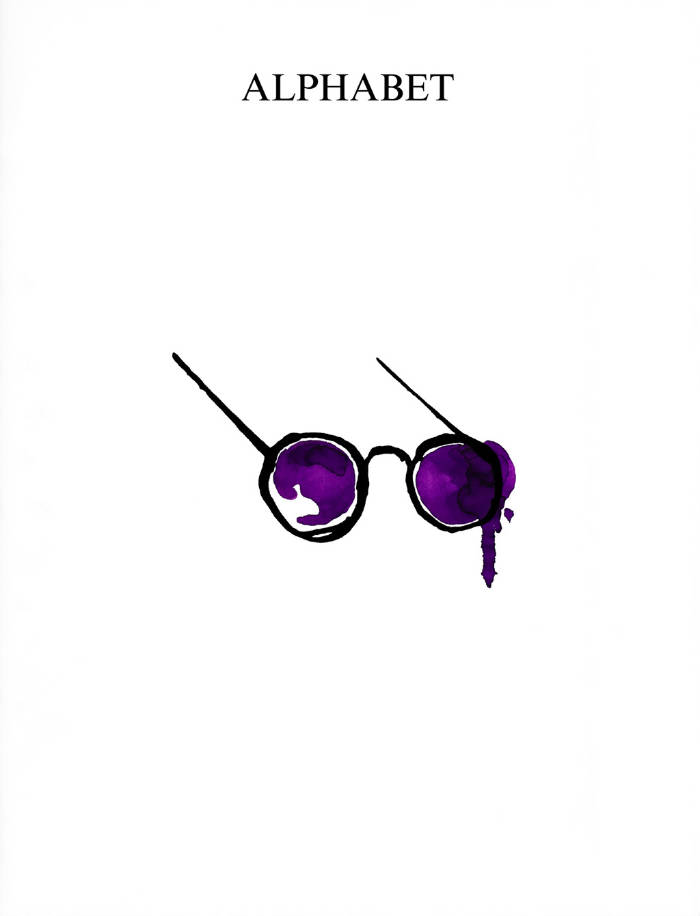
Alphabet Magazine #01
The first issue of the magazine made by artists, founded by Donatien Grau and Thomas Lenthal. Contributions by Mathias Augustyniak, Naomi Campbell, Théo Casciani, Michael Chow, Pan Daijing, Es Devlin, Claire Fontaine, Edwin Frank, Theaster Gates, Nicolas Godin, Alejandro Jodorowsky, Hedi El Kholti, Michèle Lamy, Paul McCarthy, Ian McEwan, Eileen Myles, Marc Newson, Hans Ulrich Obrist, Diana Widmaier Picasso, Ariana Reines, Barbara Chase-Riboud, Julian Schnabel & Jason Momoa, Hanna Schygulla, Juergen Teller, Iké Udé, McKenzie Wark, Robert Wilson, Yohji Yamamoto.
Alphabet is the artists' magazine. Here, they run the show. They write, they make images, they select their own works, they interview the figures they admire, they tell us what we did not know about them nor could have ever fathomed about life. This magazine is conceived entirely to put them in the driver's seat, and to enable readers to become part of the unique vision of some of today's greatest luminaries.
It is a manifestation of the creative community, coming together from all fields, from all generations and threads of culture. Writers, musicians, designers, painters, sculptors, poets—artistic figures of every kind converse all the time in their lives, but they did not have a shared space for their editorial projects. This is it.
Everyone who finds their way into Alphabet has made a mark on life, art, and culture, in a way that signals their importance to the present. Some of the contributors may be world famous, others well respected, others on the way to becoming the legends they already are. Their relevance to culture is the same, and that is why they all belong here, in the endeavor of the creative community. There is no hierarchy of status, or domain, or apparent impact. Some of the greatest revolutions happen undercover. Some of the most established voices are still breaking ground. The magazine's premise is simple: the old opposition between pop and underground does not make sense anymore. There are many creative communities, each following its own rules, each inventing its own space. Here, wherever they come from, whatever their community, artists can exist together, with the same intention of changing, and improving, what life is; with the same belief that art matters more than anything else.
None of the contributors is here randomly. They keep life thrilling and exhilarating, challenge the perception of everything and anything. Their role in shaping every aspect of life can hardly be overstated. That is why they needed a place to elaborate their own alphabet, their way of ordering and structuring language, the world, and the fabric of life—a place of freedom, where everything would be done to highlight their visions, where the very design would be a shrine to their magic. Even the distribution of the magazine was conceived with artists—each contributor suggesting sites of their liking.
Alphabet is also the magazine of magazines. Here, readers find essays, fictions, poetry, visual projects, DIY methods, recommendations from those who know, even games and astrology—and an artist's alphabet, articulating an entire universe. Anything that has ever formed a section of a magazine could find its way here. Even the cover is conceived by an artist: it was conceived especially by the legendary Robert Wilson. Artists will rejuvenate what magazines are, and magazines will be kept forever young by and with them.
Founded by Donatien Grau and Thomas Lenthal, Alphabet is a bi-yearly art magazine. Not a magazine about art. It's a magazine made by artists. Each contribution like an œuvre, making it the ultimate collector piece. Each cover is designed, with the word Alphabet, by a different artist, initiating a cult series.

Myth Lab: Theories of Plastic Love
Myth Lab: Theories of Plastic Love is a genre-defiant sex-trip to post-human dimensions. If C.G Jung, magic-mushroom shaman Terence McKenna and Camille Paglia (Sexual Personae) had a three-way while binging on George Bataille and undergoing Hormone Replacement Therapy, their baby might be the erotic cocktail of Myth Lab. Its extreme theme is nothing less than the fate of the species.
“Brilliant and wild, Jack Skelley’s Myth Lab is a manifesto of exuberance disguised as a sci-fi sex test-center for the invention of communal futures. Skelley’s a mad scientist, scholar and poet.” - Chris Kraus, author of After Kathy Acker
“In Myth Lab, Jack Skelley adroitly molds an “Einsteinian elasticity between objects and ether” to the “clitoverse.” If this formulation seems too vast, just think about a) the last time you felt good about power and b) all the ways to say yes to pleasure as a source of liberation. In conducting a “cosmologic psychoanalysis,” Myth Lab thrillingly hot wires our neurons to an endless mirror stage reflective of our own instinctual nature.” - Kim Rosenfield, author of Phantom Captain
"An explosion of clit-cock-and-pop-culture worship. Skelley’s eroto-celestial universe fights back not only against the denial of desire – “also known as fuckheadocracy and market forces” – but against death itself." - Francesca Lia Block, author of Weetzie Bat
"A hallucinatory book that straddles gender studies, science-fiction, and cultural criticism (to name but three of many genres). Ever eager to use a newfound Skelley-ism, I urge everyone to read Myth Lab and be “Kardashian'd” with love (i.e buy it now, it's great)." - Susan Finlay, author of The Jacques Lacan Foundation
"In Jack Skelley’s Myth Lab, something weird and beautiful is forged in the crucible of infinite horny grief. It’s an epic, delirious descent into the inferno, navigating the concentric circles of romance and desire as literary malady, TikTok psyop, benevolent cosmological principle, and more. Simultaneously a quest, a physics experiment and an elegy. I loved following its narrator - a tender, erotomanic, Blakean particle - seeking and finding visionary head." - Daisy Lafarge, author of Love Bug